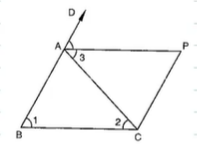O is a point in the exterior of ABC. what symbol >,< or = will you use to complete the statement OA+OB..AB? write two other similar statements and show that OA+OB+OC>12(AB+BC+CA)
To solve the problem step by step, we will analyze the given situation and apply the triangle inequality theorem.
Step 1: Understand the triangle inequality theorem
The triangle inequality theorem states that for any triangle, the sum of the lengths of any two sides must be greater than the length of the remaining side.
Step 2: Analyze the statement OA+OB?AB
Since point O is outside triangle ABC, we can apply the triangle inequality to triangles OAB, OAC, and OBC.
Step 3: Apply the triangle inequality to triangle OAB
In triangle OAB, we have:
- OA + OB > AB
Thus, we can complete the statement:
\( O A + O B > A B \)
Step 4: Write two other similar statements
1. For triangle OAC:
\( O A + O C > A C \)
2. For triangle OBC:
\( O B + O C > B C \)
Step 5: Add the three inequalities
Now we will add the three inequalities obtained:
1. \( O A + O B > A B \)
2. \( O A + O C > A C \)
3. \( O B + O C > B C \)
Adding these gives:
\(
(O A + O B) + (O A + O C) + (O B + O C) > A B + A C + B C
\)
Step 6: Simplify the left side
On the left side, we can combine like terms:
\(
2O A + 2O B + 2O C > A B + A C + B C
\)
Step 7: Divide by 2
Dividing both sides by 2 gives:
\(
O A + O B + O C > \frac{1}{2}(A B + A C + B C)
\)
Conclusion
Thus, we have shown that:
\(
O A + O B + O C > \frac{1}{2}(A B + B C + C A)
\)
The triangle inequality theorem states that for any triangle, the sum of the lengths of any two sides must be greater than the length of the remaining side.
Since point O is outside triangle ABC, we can apply the triangle inequality to triangles OAB, OAC, and OBC.
In triangle OAB, we have:
- OA + OB > AB
\( O A + O B > A B \)
1. For triangle OAC:
\( O A + O C > A C \)
2. For triangle OBC:
\( O B + O C > B C \)
Now we will add the three inequalities obtained:
1. \( O A + O B > A B \)
2. \( O A + O C > A C \)
3. \( O B + O C > B C \)
\(
(O A + O B) + (O A + O C) + (O B + O C) > A B + A C + B C
\)
On the left side, we can combine like terms:
\(
2O A + 2O B + 2O C > A B + A C + B C
\)
Dividing both sides by 2 gives:
\(
O A + O B + O C > \frac{1}{2}(A B + A C + B C)
\)
Thus, we have shown that:
\(
O A + O B + O C > \frac{1}{2}(A B + B C + C A)
\)
Topper's Solved these Questions
Similar Questions
O is a point in the exterior of ABC. what symbol >,< or = will you use to complete the statement OA+OB..AB? write two other similar statements and show that OA+OB+OC>12(AB+BC+CA)
View SolutionIn figure, O is a point in the interior of a triangle ABC, OD⊥BC,OE⊥ACand OF⊥AB. Show that
(i) OA2+OB2+OC2−OD2−OE2−OF2=AF2+BD2+CE2
(ii) AF2+BD2+CE2=AW2+CD2+BF2
 View Solution
View SolutionABCD IS A PARALLELOGRAM AND O is any point in its interior. Prove that: ar (AOB)+ ar (COD)= ar (BOC)+ ar(AOD) ar (AOB)+ar (COD)=12 ar(^(gm)ABCD) Given: A parallelogram ABCD and O is a point in its interior. To Prove: ar ( AOB)+ ar(COD)=ar (BOC)+ar(AOD)
View SolutionLet C be the mid-point of an arc AB of a circle such that m ˆAB=1830. If the region bounded by the arc ACB and line segment AB is denoted by S, then the centre O of the circle lies in the interior of S (b) in the exterior of S on the segment AB (d) on AB and bisects AB
View SolutionIn figure AB=AC and CP∣∣BA and AP is the bisector of exterior ∠CAD of ABC . Prove that ∠PAC=∠BCA (ii) ABCP is a parallelogram
View SolutionIn Figure, ABC is an isosceles triangle in which AB=AC.CPparel≤lAB and AP is the bisector of exterior ∠CAD of ABC . Prove that ∠PAC=∠BCA and (ii) ABCP is a parallelogram.
 View Solution
View SolutionO is any point on the diagonal BD of the parallelogram ABCD. Prove that ar(OAB)=ar(OBC)
View SolutionIn Fig., which of the following statements are true: (i) Point B is the interior of ∠AOB (ii) Point B is the interior of ∠AOC (iii)Point A is the interior of ∠AOD (iv)point C is the exterior of ∠AOB (v)Point D is the exterior of ∠AOC.
View SolutionIn a scalene triangle ABC,D is a point on the side AB such that CD2=ADDB, sin s∈AS∈B=sin2C2 then prove that CD is internal bisector of ∠C.
View SolutionABCD is a parallelogram, G is the point on AB such that AG=2GB,E is a point of DC such that CE=2DE and F is the point of BC such that BF=2FC. Prove that: arEGB=16ar(ABCD)
View Solution

